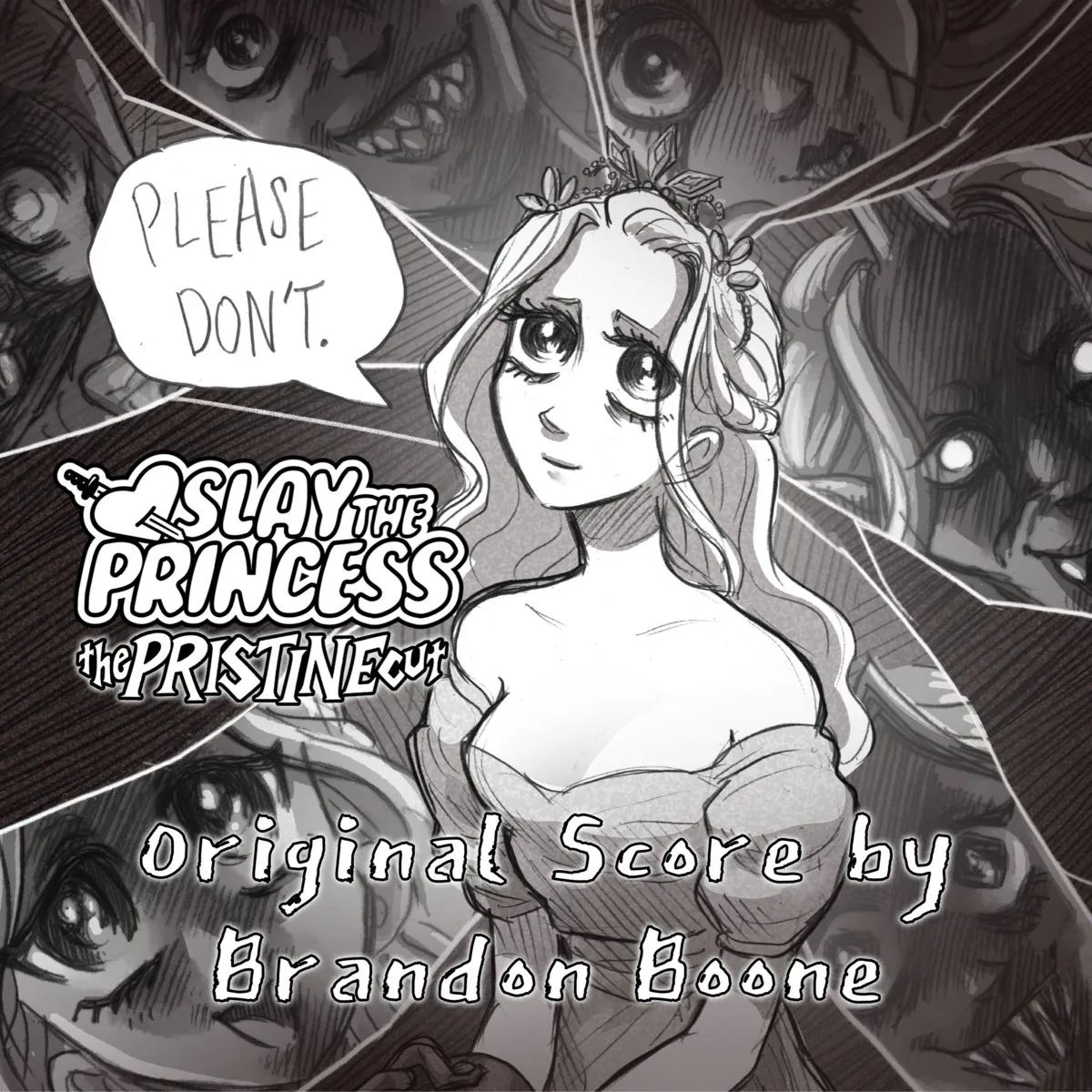Released one year after the original Slay the Princess, Black Tabby Games published Slay the Princess: The Pristine Cut, a massively upgraded version of the original in every way. This upgrade was a free content update for existing players. The Pristine Cut also expanded the game‘s release from PC to all current consoles. This was and is the definitive edition of the game.
As for The Pristine Cut‘s soundtrack? Composer Brandon Boone wrote 18 new tracks for all of the expanded content. He also included all eight live-recorded tracks released in March 2024 on the Slay the Princess Live! digital EP for this release, as well as the other two movements of “The Shifting Mound” not included on the Live EP (One and Four). Having these tracks included on TPC was a great choice. They sound so beautiful in-game. Among these orchestral recordings, I particularly enjoy “The Shifting Mound Movement V” and “Apotheosis.”
Much of the new music accompanies the game’s three new routes: “The Princess and the Dragon,” “The Cage,” and “Happily Ever After.” Some new music was also written for expanded chapter content (“The Den,” “The Fury,” “The Apotheosis”) and some new ending paths. Much like what we find in the base OST, TPC has some songs that best enjoyed in the context of the game. For example, “A Prison of Flesh” is a disturbing piece of music, and one that is perhaps hard to appreciate without the accompanying plot and visuals. However, as it builds toward “Rhythm of the Flesh” and ultimately “Hand in Claw,” it may be possible to appreciate it as a precursor to the latter track. “Hand in Claw” utilizes the same minor key melody as “The Apotheosis” and so many others, but the industrial EDM vibes, including that off-key piano sound, feel very Nine Inch Nails. Having recently learned that Boone enjoys the work of Trent Reznor and Atticus Ross, the inspiration makes a lot of sense to me.
The effect-heavy, all-vocal mix “A Tapestry Undone” uses the stem vocalizations from Amelia Jones to create something downright chilling. Layering her vocals and pitching across multiple octaves makes for a genuinely frightening soundscape.
One of my favorite track titles here, “Thirty-Trillion Cells,” buries the melody in the bass line while claps and other sharp percussive noises hold the listener’s attention. This is a very well-written piece, utilized in one of the stranger parts of The Pristine Cut. If you keep going, “An Empty Void that Dared to Dream It Was Alive” takes this seem form and builds even more percussion, to the point that it could serve as a slow groove on the dance floor of a club—but only if the club was into some macabre stuff.
Moving to more dulcet tones, the title music for “The Princess and the Dragon” chapter deftly utilizes Amelia Jones humming one of the counter-melody lines she developed with Boone. For those familiar with what occurs in this chapter, the intentional use of humming here is quite smart. The added decorative piano work helps to flesh out this piece quite well. I would argue it’s one of the strongest additions in TPC.
The only thing stronger? Honestly, we have to give it to all of the music in the “Happily Ever After” chapter, a special epilogue to “The Damsel” that might be the most impressive part of all the expanded content. This includes “Our Happy Ending,” “What Remains After the Fire,” and “I Meant It.” This last piece, “I Meant It,” is one of the shortest on The Pristine Cut OST, clocking in at just under two minutes. Yet, it is easily one of the most moving pieces on the OST, and especially so if you’ve played this chapter for yourself. Because this entire soundtrack is based on only a handful of melodies and chord progressions extended, expanded, and warped and twisted every which way, it can feel monotonous.
And, so too, can stories about the same characters. And, if I may go deep with this one, so can our own stories, especially in a long-term relationship with a life partner. “Happily Ever After” gets at the heart of day-to-day existence in a romantic relationship. We experience the law of diminishing returns on activities we once found pleasurable. We can become discontent. It can hurt, and there can be sorrow. Is there any way to turn this around?
The song “I Meant It,” and the dialogue this music accompanies in Slay the Princess: The Pristine Cut, provides a powerful answer. Perhaps an over-simplification, and yet, something quite real.
If you already owned this game on Steam and got the Supporters Pack for the OST, guess what? You already own this soundtrack, even if you didn’t realize it! If you don’t have the Supporters Pack, that is one way to get access to this soundtrack. Another great way to pick up Slay the Princess: The Pristine Cut Original Soundtrack is via Brandon Boone’s Bandcamp page. If you enjoyed the base game and its soundtrack, I’d encourage you to get this OST so you have the complete music collection. If you are new to Slay the Princess, I’d recommend getting all the music together. Just one or two runs through this game and you may find yourself wanting to hear “The Princess” and all its variations at your convenience.

